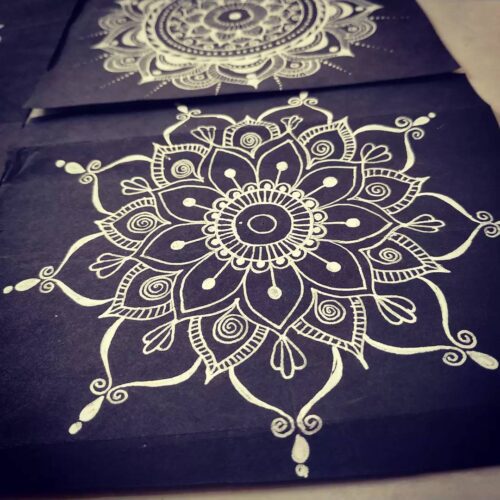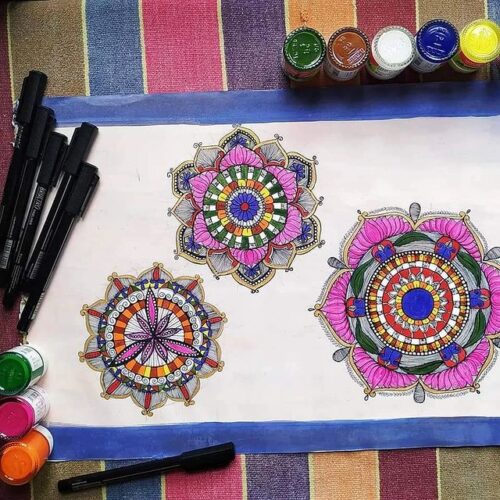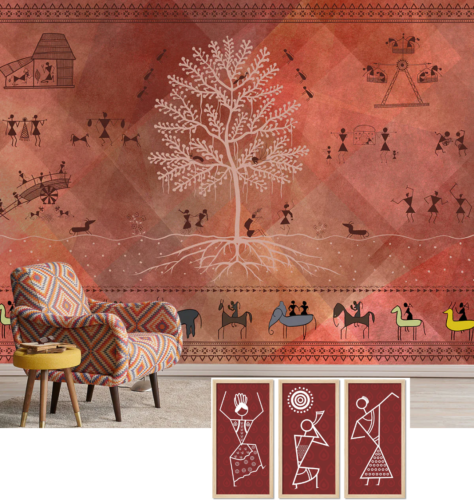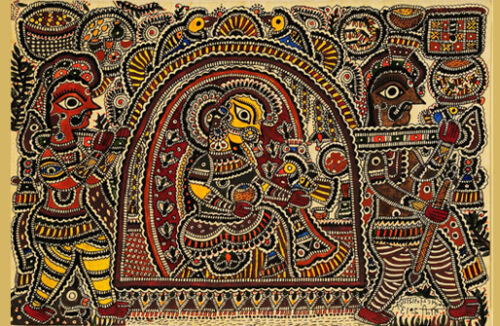Rangoli: A Cultural Art of India
“A symphony of colors and creativity, where each stroke tells a story, and every dot reflects a tradition. Rangoli: A Cultural Art of India dances with joy, adorning thresholds and hearts, bridging the gap between past and present, and reminding us of the timeless beauty that resides within India’s heritage.”
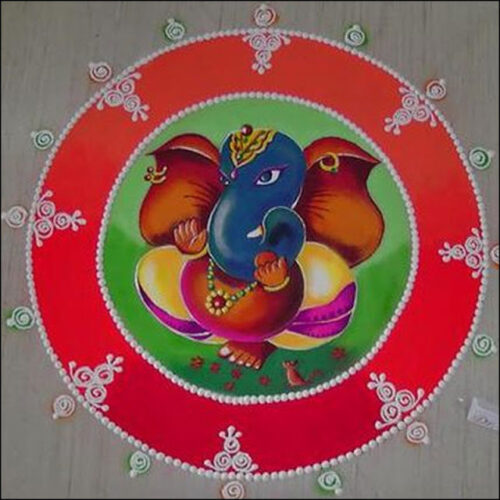
To delve deeper into this topic, let’s explore a list of key factors that contribute to its significance and impact.
Definition and significance
Rangoli, a vibrant and symbolic art form, holds deep cultural significance and represents India as well. It involves creating intricate patterns using colored powders, rice flour, or flowers. Rangoli connects people with their spirituality, folklore, and cultural heritage. Rangoli is that beautiful that one can create it with any material.
It adorns homes, temples, and public spaces during festivals, bringing good fortune and creating a welcoming atmosphere. With regional styles like Kolam in Tamil Nadu and Phulkari Rangoli in Punjab, Rangoli showcases India’s diverse cultural heritage.
Rangoli is just not a piece of art, it conveys beautiful messages too. This transient art form celebrates the present moment, fostering creativity, strengthening bonds, and preserving traditions. Join us on this journey to discover Rangoli: A Cultural Art of India.

What is Rangoli called in different languages in India
- 1. Hindi: Rangoli
- 2. Tamil: Kolam
- 3. Telugu: Muggulu
- 4. Kannada: Rangoli
- 5. Malayalam: Pookkalam
- 6. Marathi: Rangoli
- 7. Gujarati: Rangoli
- 8. Bengali: Alpana
- 9. Punjabi: Rangoli
- 10. Odia: Muruja
- 11. Urdu: Rangoli
- 12. Sindhi: Rangoli
- 13. Nepali: Alpana
- 14. Assamese: Alpona
- 15. Manipuri: Rangoli
- 16. Konkani: Rangoli
- 17. Maithili: Rangoli
- 18. Bhojpuri: Rangoli
- 19. Kashmiri: Rangoli
- 20. Rajasthani: Mandana
- 21. Malay: Rangoli
- 22. Sinhala: Rangoli
- 23. Haryanvi: Rangoli
- 24. Dogri: Rangoli
- 25. Kumaoni: Rangoli
- 26. Garhwali: Rangoli
- 27. Tulu: Pade
- 28. Santali: Punji
- 29. Kokborok: Holong
- 30. Mizo: Ziahpui
- 31. Sikkimese: Nangser
- 32. Arunachali: Phaan
- 33. Meghalaya: Ka Janeiñ
- 34. Tripuri: Kokmohra
- 35. Manipuri (Meiteilon): Chongba
- 36. Karbi: Rangkai
- 37. Ao Naga: Tsungremmong
- 38. Khasi: Ka Raitam
- 39. Garo: Chadam Chokre
- 40. Lepcha: Munthok
- 41. Bhutia: Rangthok
- 42. Tangkhul Naga: Thuirom
- 43. Sherdukpen: Tsehtan
- 44. Angami Naga: Vesüpru
- 45. Nyishi: Manat
- 46. Chakma: Achikrang
- 47. Ao: Tsungremtsi
- 48. Karbi: Jangring
- 49. Mising: Gámre
- 50. Manipuri (Kabui): Sóh
And many more. These names represent the diverse linguistic landscape of India and the neighboring regions, showcasing the varied regional names for the art form of Rangoli.

Historical roots and cultural importance
In Sri Vaishnavism, it is believed that Andal, one of the twelve Alvars, worshipped the deity Krishna and was wedded to him during the month of Margazhi. As a part of this tradition, unmarried women rise before dawn during this month and create rangoli designs to welcome the deity. The creation of rangoli is also mentioned in Hindu literature, indicating its presence and significance in cultural and religious practices.
Rangoli, deeply rooted in history, holds immense cultural importance in India. Originating from ancient times, Rangoli is a traditional art form that symbolizes spirituality, creativity, and unity. It is believed to ward off evil and invite positive energies. Rangoli’s intricate patterns and vibrant colors reflect the rich cultural heritage of the subcontinent.

Passed down through generations, it connects communities and celebrates festivals and auspicious occasions. Rangoli serves as a medium to express devotion, showcase artistic skills, and honor traditions. Its transient nature reminds us to cherish the beauty of the present moment. Rangoli stands as a testament to India’s artistic legacy and cultural diversity.
Rangoli in different states
It is the most Decorative art of India. It is made in every special occasion whether its religious event, family function or festivals. India is rich in cultural diversity, and Rangoli is practiced across the country. While Rangoli is popular in various regions of India.
There are a few places that are renowned for their association with Rangoli:
1. Rajasthan: Known for its vibrant colors and intricate designs, Rajasthan is famous for its Rangoli art. Cities like Jaipur, Udaipur, and Jaisalmer host Rangoli competitions and exhibitions during festivals like Diwali and Holi.
2. Maharashtra: Maharashtra, particularly the city of Mumbai, is known for its grand Rangoli displays during the festival of Ganesh Chaturthi. Mumbai’s Lalbaugcha Raja Mandal is famous for its elaborate Rangoli decorations.
3. Tamil Nadu: In Tamil Nadu, Rangoli is an integral part of daily rituals and festivities. The town of Kolam in Tamil Nadu is renowned for its exquisite and intricate Rangoli designs made with rice flour or chalk powder.
4. Karnataka: Mysore, in the state of Karnataka, is known for its grand Rangoli displays during the Dasara festival. The Mysore Palace becomes the focal point for elaborate Rangoli decorations created by skilled artists.
5. Gujarat: Gujarat is famous for its colorful and vibrant Rangoli art. The city of Ahmedabad hosts the International Kite Festival where Rangoli competitions are also held, showcasing the artistic skills of participants.
6. Uttar Pradesh: In Uttar Pradesh, Rangoli is particularly popular during festivals like Diwali and Holi. The cities of Varanasi and Mathura witness beautiful Rangoli displays during these festive occasions.
7. West Bengal: In West Bengal, Rangoli is known as “Alpana” and is an integral part of religious rituals. During festivals like Durga Puja, intricate Rangoli designs are created in households and community pandals.
8. Kerala: In Kerala, Rangoli is known as “Pookalam” and is a prominent part of the Onam festival. Colorful floral Rangoli designs are created using fresh flower petals, enhancing the festive spirit.
These are some of the major places in India where Rangoli holds significant cultural and artistic importance. However, Rangoli is practiced in various other regions and states of India, each with its own unique style and traditions.
Kinds of Rangoli: A Cultural Art of India
Rangoli can be distinguished by their shape, motifs, used material, states or region. Now in modern days or should be said technology era; we are reachable to each type of Rangoli. We can get materials easily. Learning and reaching out it with society is easier.
These are some of the major forms of Rangoli practiced in different regions of India:
1. Alpana (West Bengal): Alpana is a traditional form of Rangoli found in West Bengal. It involves creating intricate designs using rice paste or chalk powder. Alpana designs often feature floral motifs and are an integral part of auspicious occasions and festivals like Durga Puja.
2. Aripan (Bihar): Aripan is a traditional form of Rangoli practiced in Bihar. It involves creating designs using rice paste or chalk powder and often depicts intricate floral patterns, birds, and religious symbols.
3. Aipan (Uttarakhand): Aipan is a form of Rangoli practiced in Uttarakhand. It involves creating intricate geometric patterns using rice flour or colored powders. Aipan designs are commonly seen during weddings, festivals, and other auspicious occasions.
4. Jhoti or Chita (Odisha): Jhoti or Chita is a form of Rangoli practiced in Odisha. It involves creating intricate white designs on the floor or walls using rice paste or chalk powder. Jhoti designs are often associated with religious and cultural rituals.
5. Kolam (Tamil Nadu): Kolam is a popular form of Rangoli predominantly practiced in Tamil Nadu. It involves creating intricate geometric patterns using rice flour or colored powders. Kolam designs are created daily at the entrance of homes and are believed to bring good luck and prosperity.
6. Muggu (Andhra Pradesh): Muggu is a form of Rangoli popular in Andhra Pradesh. It involves creating intricate designs using rice flour or colored powders. Muggu designs often have symmetrical patterns and are created as a daily ritual at the entrance of homes.
7. Madana (Rajasthan): Madana is a traditional form of Rangoli practiced in Rajasthan. It involves creating intricate designs using colored powders, flowers, and other natural materials. Madana designs often depict peacocks, flowers, and other elements inspired by nature.
8. Rangoli (Gujarat, Karnataka, and Maharashtra): Rangoli is a widely practiced form of Rangoli in Gujarat, Karnataka, and Maharashtra. It involves creating colorful and vibrant designs using colored powders, flowers, and decorative items. Rangoli designs vary in style and can be intricate or freehand.
9. Chowkpurana (Uttar Pradesh): Chowkpurana is a form of Rangoli practiced in Uttar Pradesh. It involves creating symmetrical and geometric patterns using colored powders, flower petals, and other natural materials.
Besides of above these are some of the various forms of Rangoli, each with its own distinctive style, cultural significance, and regional influence:
Sathiya (Gujarat), Pookalam (Kerala), Bhumi Rangoli, Tanjore Rangoli (Tamil Nadu) ,Kalamkari Rangoli, Mandana (Rajasthan), Sanskar Bharti Rangoli (Maharashtra), Phulkari Rangoli (Punjab), Warli Rangoli (Maharashtra), Gond Rangoli (Madhya Pradesh), Chitra Rangoli (Tamil Nadu), Ganesha Rangoli, Diya Rangoli, Floral Rangoli, Geometric Rangoli, Freehand Rangoli, Dot Rangoli, Theme-based Rangoli, Floating Rangoli, Swastika Rangoli, Nature-inspired Rangoli, Abstract Rangoli, Peacock Rangoli, Lotus Rangoli, Bird Rangoli, Mandala Rangoli etc.
In modern times many artists perform 3D Rangolis.
Creation and Materials
Handcrafted designs and intricate patterns:
Rangoli designs by hand, whether on the ground or on a flat surface. It has easy to intricate patterns as per events. From National events to everyday religious routine we can see Designs like Geometric shapes, floral motifs, Text, Historical personalities and auspicious symbols all drawn by hands by using Rangoli material.
Intricate designs are mostly can be seen in big events of India. These designs involves motifs and symbols related to event and takes hours to complete. The finishing of such designs can leave one amazed and can’t be differentiate that these are made by hands. 3D Rangoli and Portrait Rangoli are a one of these too that looks like real images or sketches.
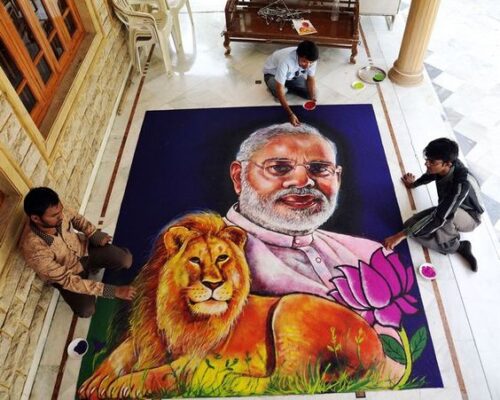
Traditional materials and colors:
The traditional materials used in Rangoli are flowers, leaves, liquid color, rice flour, colored powders, turmeric, vermillion, and plant-based dyes. Colors like Red, Yellow, white, green, pink and mostly bright colors are favourably used by artistss, as they give good visuals.
There is a significance of using natural materials. They don’t harm anything either its artist’s hands, flooror animals. Also Its cruelty free with natural Adour and it’s compostable too.
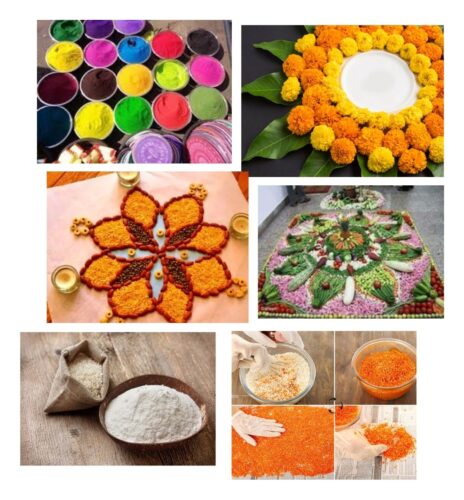
They have an association with cultural practices too. The use of these materials reflects the deep-rooted connection to nature and the belief in the power of colors to bring joy and good fortune. Additionally, the fragrant flowers and their vibrant hues not only enhance the visual appeal but also create a harmonious and inviting atmosphere during festive occasions.
The use of traditional materials in rangoli is a way of preserving cultural heritage and passing down artistic traditions from one generation to the next.
Geometric shapes, floral motifs, Text and auspicious symbols:
Describe the common elements found in Rangoli designs, including geometric shapes, floral patterns, peacocks, deities, and other symbols with auspicious meanings. Geometric shapes such as circles, squares, and triangles are often incorporated to create intricate patterns and symmetry. These shapes symbolize unity, harmony, and balance in life.
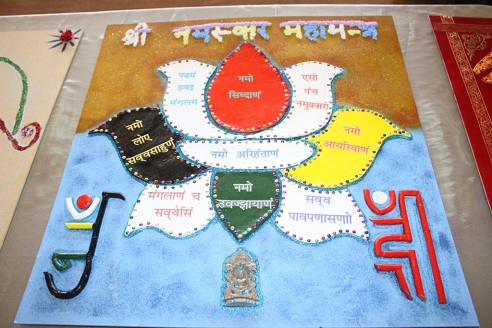
Floral motifs, such as lotus flowers or blooming buds, represent beauty, purity, and the cycle of life. They infuse the rangoli with natural elements and invoke a sense of spirituality and vitality.
Auspicious symbols like the swastika, om, or kalash are commonly used in Rangoli designs. These symbols hold deep cultural and religious significance in India. The swastika signifies good luck and prosperity, while the om represents divine energy and the ultimate reality. The kalash symbolizes abundance and fulfillment.
The depth and symbolism elevate Rangoli from a mere visual delight to a profound expression of tradition and values.
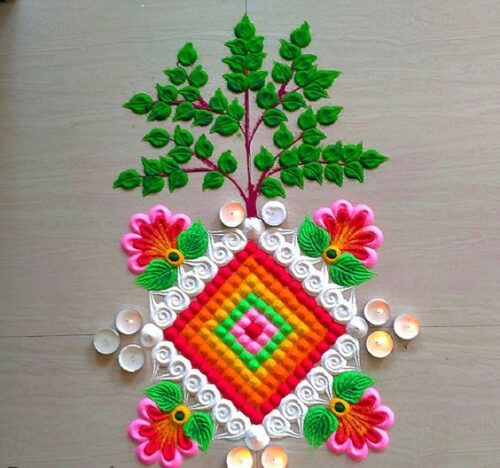
Traditional methods of creating:
Traditional methods of creating Rangoli involve a few key steps. Here are the steps commonly followed:
- Surface Preparation: The area where Rangoli will be made is cleaned and smoothed to ensure a clean canvas. This is typically done by sweeping and mopping the floor or applying a layer of powdered white rice or chalk to create a base. The most Traditional ritual is made by applying “Gobar” (Cow dung) on Soil floor or any other.
- Design Sketching: Before starting the actual rangoli, a rough outline or sketch of the design is drawn using chalk or rice flour. This helps guide the artist and maintain symmetry.
- Material Selection: Traditional materials like colored powders (rangoli or gulal), rice flour, turmeric powder, vermillion, or flower petals are chosen for filling in the design. These materials are mixed with water or oil to create a paste-like consistency.
- Filling the Design: The artist starts filling the design using their hands or a small tool like a cone or spoon. They carefully pour or sprinkle the chosen materials onto the sketch, following the outlines and creating intricate patterns.
- Adding Details: Once the primary design is filled, additional details like dots, lines, or smaller patterns are added to enhance the overall look of the rangoli. These details can be made using different colors or materials.
- Final Touches: The rangoli is allowed to dry and set. Additional decorative elements like diyas (oil lamps), flower petals, or small ornaments may be added to further enhance the rangoli’s beauty.

These traditional methods require skill, patience, and creativity. They have been passed down through generations, and while modern tools and materials are now available, many artists still adhere to these traditional techniques to preserve the cultural essence of Rangoli-making.
Rituals and Symbolism
In Sri Vaishnavism, it is said that Andal, one among the twelve Alvars, worshipped the deity Krishna, and was married to him in the month of Margaḻi. During this month, several unmarried women get up before dawn, and draw a Rangoli to welcome the deity. Mentions of Rangoli creation are also found in Hindu literature.

Auspiciousness and attracting positive energy:
It has a strong belief that creating Rangoli invites good luck, prosperity, and positive energy into the home. It is considered an auspicious ritual, especially during festivals like Diwali, Ganeshotsav, Pongal, Navratri, Ramanavami and special events.
Rangoli attracts positive energy through vibrant colors, geometric patterns, and mindful creation. The use of bright colors creates a cheerful atmosphere, while geometric patterns and symmetry promote balance and harmony. Creating Rangoli requires focus and concentration, inducing a mindful state that reduces stress and fosters positivity.

Rangoli is often made with sacred intentions, inviting blessings and positive energies. The communal aspect of Rangoli brings joy and social connection, further enhancing the positive energy. Symbolic representations in Rangoli also contribute to its ability to attract positivity.
Women’s role and communal creation:
In India women are consider as deity. Women are backbone of any happy family, hence the importance is immense. As women represents the creator of any family and country so when it comes to cultural and spiritual aspects they play a significant role.

In Rangoli making due to cultural tradition, creative expression, home decoration, symbolism of goddess, and social bonding women have the best view. Rangoli making has been passed down through generations, with women taking responsibility for preserving and showcasing their artistic skills. They beautify the home and create a welcoming atmosphere. In some traditions, Rangoli represents the goddess, allowing women to connect with the divine feminine energy.

Many women practice this art everyday outside of their entrance door. They draw symbols of Laxmi-Charan, Swastik, shubh-labh and by writing Sri Ram And Sri Hari. Rangolis are not limited to one location with one type. We have vast creativity and cultural as well spiritual advantages of it. Rangoli making also becomes a social activity where women bond and strengthen relationships.
Storytelling and cultural narratives:
Rangoli serves as a medium for storytelling and cultural narratives. There are certain designs are associated with specific festivals, mythological tales, or regional customs, helping to preserve and transmit cultural heritage. Rangoli changes with seasons and festivals, reflecting cultural narratives associated with them.
Rangoli depicts cultural narratives such as scenes from the Ramayana and Krishna Leela, agricultural motifs for harvest festivals, regional folklore, festive symbols, and religious rituals. Sometimes texts like Shlokas and Mantras are also drawn that makes it more auspicious. It is also use for spreding awareness in socirty for difrrent aspects.
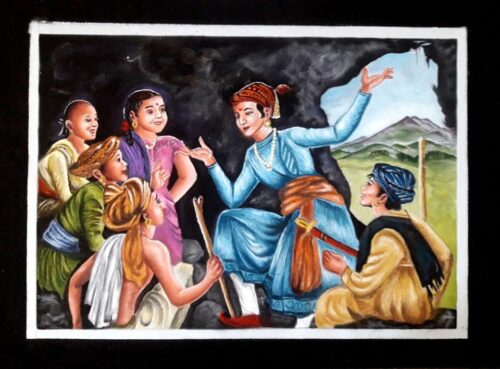
Historical and Religious events, Stories of Deities and Social Messages are a most favorite choice for Rangoli practices of many Rangoli Artist.
Symbolic motifs and regional influences add depth to the narratives represented. Rangoli’s presence in rituals and celebrations visually communicates cultural customs and values. It becomes a visual language that connects individuals with their heritage, fostering pride and a sense of belonging.
Artistic Expression and Technique
There is a artistic aspect of Rangoli, where artists use their imagination and skills to design unique patterns and showcase their creativity. Rangoli allows an artist to draw personal expression within the confines of tradition. Few techniques are that amazing to make one unable to differentiate between real Image and a Rangoli. 3D designing techqnique is one of them too.
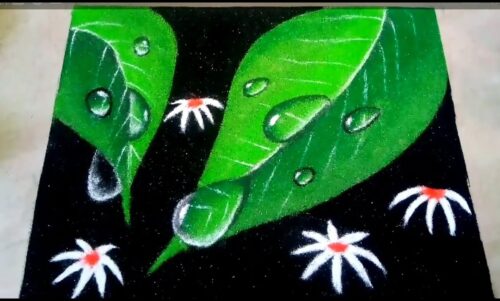
Artists have meticulous process involved in creating Rangoli, requiring precision and attention to detail. They use fingers, palms, and tools like cones and stencils to carefully place the colored materials and achieve intricate patterns.
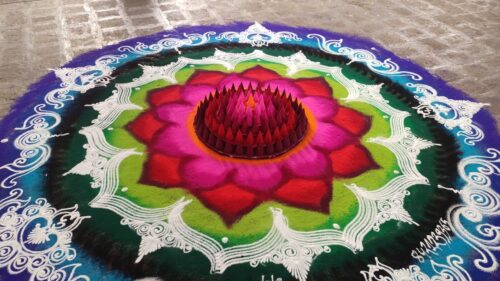
From geometric shapes to free-flowing curves, rangoli patterns can be as simple or as complex as the artist desires. Techniques such as layering, shading, and blending colors are employed to create depth and visual appeal. Artists also use various tools like fingers, brushes, and even cloth to achieve desired effects.
Therapeutic and calming process
Yes, definitely it is Therapeutic. The process of making make one lost in it. It can be said that it so satisfying to watch it been made or by making. The rhythmic motion and the sound produced during the creation process can have a soothing effect on the artists and viewer.
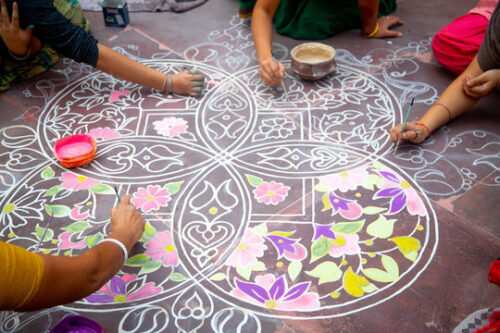
The act of creating Rangoli requires focus and concentration, allowing individuals to enter a meditative state that promotes relaxation and reduces stress. The repetitive nature of the intricate patterns and the rhythmic motions involved in filling the designs can have a soothing effect on the mind. Additionally, the vibrant colors used in Rangoli evoke positive emotions and uplift the mood.
Engaging in Rangoli creation provides a sense of accomplishment and fulfillment, offering a therapeutic escape from the pressures of daily life. The experience may differ from person to person.
Global Recognition and Appreciation
Rangoli has gained global recognition as a unique and vibrant art form. Its intricate designs, cultural significance, and artistic expression have captivated people worldwide. Rangoli workshops, exhibitions, and cultural exchanges have helped showcase its beauty, leading to its recognition as a cherished art form beyond its cultural origins.
The advent of social media and online platforms has played a significant role in spreading the art of Rangoli globally. Artists and enthusiasts share their intricate designs, techniques, and tutorials, allowing people from different parts of the world to learn about and practice Rangoli. This accessibility has contributed to its growing popularity worldwide.
Events:
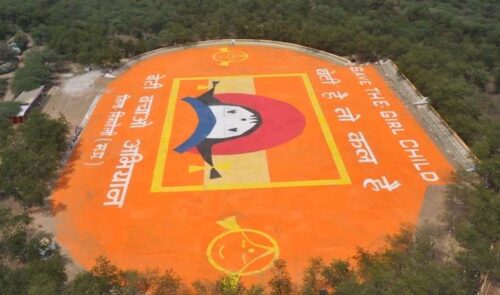
In 2013, the Singrauli district administration created the world’s largest rangoli, measuring an impressive 22,863 square meters. This remarkable achievement not only earned recognition from the Guinness Book of World Records but also secured a prominent position in the Golden Book of World Records and India Book of Records. The Rangoli showcased ‘Save the Girl Child’ exemplifying the artistic prowess and creativity of the individuals involved in its creation. This monumental feat stands as a testament to the rich cultural heritage and artistic traditions of India.
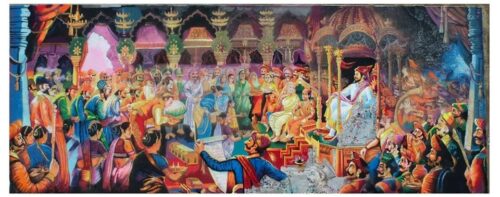
The world record for the “Largest Rangoli Pattern” was achieved by the Shiv Rajyabhishek Vishwa Vikrami Rangoli Utsav Samiti from Sangli, Maharashtra, India, on February 15th, 2019. This remarkable feat involved 80 members of the Samiti who dedicated three days to create a Rangoli measuring 1,06,425 square feet (495 feet wide and 215 feet in height). Their exceptional accomplishment earned them a place in the International Book of Records, setting a new world record.
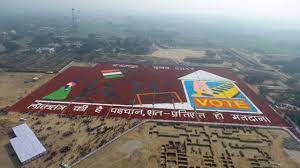
To promote voter participation, the district of Mirzapur in Uttar Pradesh, known for Naxalite activities, made an ambitious attempt to set a Guinness World Record for creating the largest Rangoli. On National Voters Day in 2017, approximately 3,500 students and teachers from 50 schools joined forces, utilizing around 120,000 kilograms of colors to craft an enormous Rangoli spanning an impressive area of 39,125 square meters. The record-setting endeavor took place at the premises of the Government Polytechnic Institute, with enthusiastic involvement from school children, educators, district administration officials, and members of the civil society in Mirzapur.

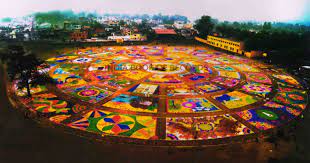

These are one with the World record holder Rangolis. There are many more to glorify the creative beauty of India through Rangoli.
Best and Global Award Winning Rangoli Artists of India…
Conclusion
Rangoli is a mesmerizing art form that brings colors, joy, and auspiciousness to various occasions and celebrations in India. It is a beautiful expression of creativity, cultural heritage, and community bonding. By creating intricate designs on the floor, Rangoli adds a touch of splendor to festivities and serves as a medium to welcome prosperity and good luck.
Rangoli: A Cultural Art of India

